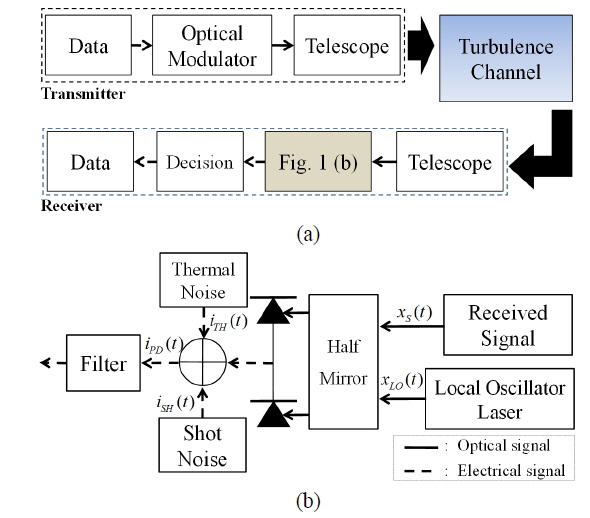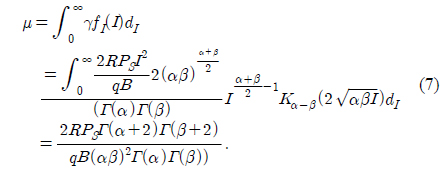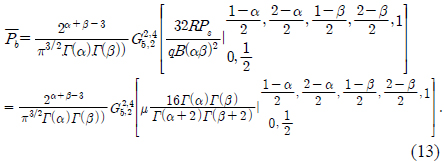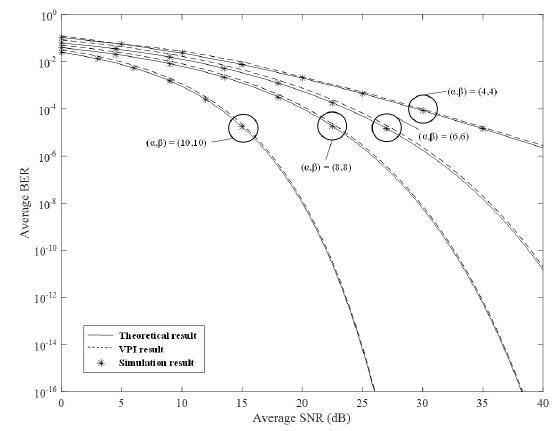



Free-space optical (FSO) communication systems [1-5] are commonly used to provide an attractive and cost-effective link for high-data-rate wireless transmission. FSO systems support diverse applications ranging from highly directive point-to-point links for terrestrial last-mile and long-haul intersatellite solutions to quick and efficient deployment in densely populated urban areas or in unstructured environments such as disaster-prone areas.
FSO systems utilize a free-space medium for transmission, but they are inherently affected by atmospheric conditions, among which turbulence has the most significant effect, especially for high-data-rate point-to-point links. As such, it is an interesting problem to analyze the degradation of signal strength due to scintillation of the optical signal as well as link performance against atmospheric turbulence channels. In atmospheric turbulence channels, the coherence time of the channels is on the order of milliseconds, which is typically much larger than the one-bit time interval of gigabit-per-second (Gbps) FSO signals [6-11]. Hence, for a one-bit time interval, the FSO channels are modeled as a constant and random variable that is governed by a log-normal, K, or gamma-gamma distribution. The gamma-gamma distribution is a tractable mathematical model with a multiplication of two parameters of small-scale and large-scale irradiance fluctuations, the probability density functions (PDFs) of which are independent gamma distributions, and it provides excellent agreement between theoretical and simulation results [6-8].
Many authors have intensively researched and analyzed several implementation techniques for FSO systems under turbulence. In Ref. [8], a performance analysis for intensity modulation-direct detection (IM-DD) FSO systems over gamma-gamma turbulence channels was presented. For coherent FSO systems, Refs. [12] and [13] proposed alternative implementations enabling a higher receiver sensitivity than that of IM-DD, especially when the power of the local oscillator laser is sufficiently high; Refs. [6] and [14] presented analyses of coherent heterodyne DPSK systems over K and gamma-gamma turbulence channels, respectively, considering thermal noise caused by the high operating temperature of FSO systems. Coherent PSK requires the proper control of laser coherence, which is challenging in FSO systems because of difficulties associated with the phase-locking of the local oscillators. However, coherent PSK is expected to provide performance benefits over DPSK. Furthermore, there are known results indicating that the performance of coherent FSO systems is limited by the shot noise of the receiver, which heterodynes with a local oscillator laser having sufficiently high power; this needs to be analyzed further under turbulence channels.
In this study, we derived a generalized closed-form expression for the average BER performance of coherent FSO systems by using binary phase shift keying (BPSK) over atmospheric turbulence channels, in which the turbulence-induced fading of the signal intensity is described by a gamma-gamma distribution. Moreover, theoretical results are provided to understand the degradation of performance as a function of scintillation depth. Analytical results are further confirmed through Monte Carlo simulations and VPI transmission Maker results.
The overall architecture of coherent FSO systems is shown in Fig. 1 (a). The optical modulator processes data by using a laser at a transmitter. The output signal of the optical modulator is transmitted via atmospheric turbulence channels between telescopes. In Fig. 1 (b), the received signal is combined with a local oscillator laser through a half-mirror at a receiver. Then, a photodetector detects the compound optical signals to generate the photocurrent. Finally, a decision module extracts data. In this section, we explain the coherent PSK receiver in detail because it is the basic model for coherent receivers and can be adapted to other modulation receivers. In Fig. 1 (b), the received optical signal and the local oscillator laser in scalar form can be expressed, respectively, as [12, 13]
where
where
where
In coherent FSO systems, if the power of the local oscillator laser were sufficiently high, the second term in the denominator of Eq. (4) would vanish. Thus, Eq. (4) is reduced to [5]
As in [7] and [8], the PDF of a gamma-gamma distribution is represented by the product of small-scale and large-scale irradiance fluctuations, both of which have gamma distributions. The gamma-gamma distribution is
where I >0, is the average irradiance of the channel,
III. DERIVATION OF THE AVERAGE BER
In this section, we derive the average BER of coherent FSO systems according to BPSK modulation. We first calculate the average SNR (µ) using [15, Eq. 07.34.21.0009.01] as follows:
The conditional BER,
where
and
Thus, the conditional BER (Eq. 8) and gamma-gamma distribution (Eq. 6) can be represented by the Meijier G function using Eqs. 9 and 10. Thus, the average BER ( ) can be obtained using the following integral:
By substituting Eqs. (6) and (8) into Eq. (11), we can obtain the following equation:
Finally, by using the classic Meijer integral of the two G functions [15, Eq. 07.34.21.0011.01], Eq. 12 is simplified as follows:
Figure 2 represents the results for a closed-form expression of the average BER, , as a function of the average SNR at different turbulence strengths. For instance, we considered the following turbulence strengths: (
Figure 2 plots the average BER as a function of the average SNR for different turbulence channel strengths. Recall that the channel strength depends on the scintillation parameters,
We obtained a closed-form expression for the average BER of coherent FSO systems over atmospheric turbulence channels with a gamma-gamma distribution by using special integrals and transformations of the Meijer G function. Furthermore, we simulated the average BER performance using the Monte Carlo method to confirm the theoretical results. Simulation results show an excellent agreement with the analytical results. Therefore, we can more easily predict BER performance by using a simple closed-form expression without any complicated calculation. In practical terms, when we establish coherent FSO systems, we can create an engineering table by using the derived BER.














